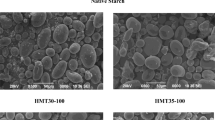Conclusion
The acid hydrolysis of potatoes does not appear promising as a method of processing cull and surplus potatoes for storage or transportation. Elevated pressures do not seem to have much advantage, although they produce results in a shorter time or with less acid. To avoid decomposition, high acid concentrations would be required, and the resulting syrups would be difficult to concentrate. The statement, “In order to be suitable for commercial use, the agent promoting hydrolysis must give a high rate of hydrolysis as compared with the rate of sugar decomposition” (3) applies with the same force to the hydrolysis of potatoes as to the hydrolysis of wood cellulose. The rate of decomposition of potato hydrolyzates seems to increase more rapidly with temperature than the rate of hydrolysis, and the ratio is more favorable for wood cellulose than for potatoes. This method of hydrolysis is more promising when the hydrolyzates are to be used as fermentation substrates and when it is not necessary to hydrolyze the starch completely to glucose. Relatively high acid concentrations and close control would be required to keep decomposition to a minimum. Under properly controlled conditions, the results might well be satisfactory. Use of the material as a fermentation substrate would not require the expensive concentration step.
Similar content being viewed by others
Literature Cited
Dunning, J. W., and Lathrop, E. C. 1945. The saccharification of agricultural residues. Ind. Eng. Chem. 37: 24–29.
Harris, E. E. 1949. Wood saccharification. Advances in Carbohydrate Chem. 4: 153–188.
—, and Kline, A.A. 1949. Hydrolysis of wood cellulose with hydrochloric acid and sulfur dioxide and the decomposition of its hydrolytic products. J. Physical and Colloid Chem. 53: 344–351.
Kerr, R. W. 1944. Chemistry and industry of starch. Academic Press, Inc. New York. Chapter XIV.
Maillard, L. C. 1916. Synthese des matieres humiques par action des acides amines, sur les sucres reducteurs. Ann. Chim. Series 9, (5): 258–317.
—. 1917. Identite des matieres humiques de synthese avec les matieres humiques naturelles. Ann. Chim. Series 9, (7): 113–152.
Official and tentative methods of analysis of the association of official agricultural chemists. 1945. Sixth ed. Washington, D. C. pp. 409–410.
Saeman, J. F. 1945. Kinetics of wood saccharification hydrolysis of cellulose and decomposition of sugars in dilute acid at high temperature. Ind. Eng. Chem. 37: 43–52.
Steiner, E. T., and Guthrie, J. D. 1944. Determination of starch in sweet potato products and other plant materials. Ind. Eng. Chem., Anal. Ed. 16: 736–739.
Symposium. 1945. Sugars from wood. Ind. Eng. Chem. 37: 4–54.
Author information
Authors and Affiliations
Additional information
Report of a study made under Research and Marketing Act of 1946.
One of the laboratories of the Bureau of Agricultural and Industrial Chemistry, Agricultural Research Administration, U. S. Department of Agriculture.
Rights and permissions
About this article
Cite this article
Hunter, A.S., Talley, E.A. Acid hydrolysis of potatoes under pressure. American Potato Journal 27, 425–438 (1950). https://doi.org/10.1007/BF02854253
Accepted:
Issue Date:
DOI: https://doi.org/10.1007/BF02854253




